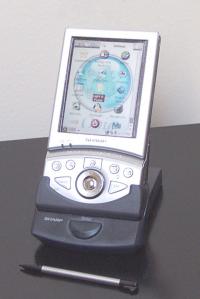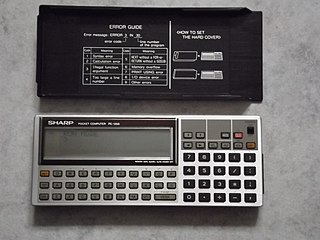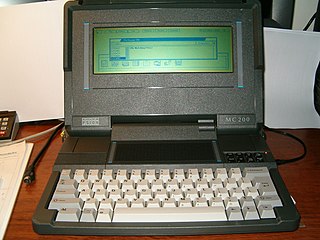Windows Embedded Compact, formerly Windows Embedded CE, Windows Powered and Windows CE, was an operating system family developed by Microsoft as part of its Windows Embedded family of products.

The Sharp Zaurus is the name of a series of personal digital assistants (PDAs) made by Sharp Corporation. The Zaurus was the most popular PDA during the 1990s in Japan and was based on a proprietary operating system. The first Sharp PDA to use the Linux operating system was the SL-5000D, running the Qtopia-based Embedix Plus. The Linux Documentation Project considers the Zaurus series to be "true Linux PDAs" because their manufacturers install Linux-based operating systems on them by default. The name derives from the common suffix applied to the names of dinosaurs.
Casio Cassiopeia was the brand name of a PDA manufactured by Casio. It used Windows CE as the Operating system. Casio was one of the first manufacturers of PDAs, developing at the beginning small pocket-sized computers with keyboards and grayscale displays and subsequently moving to smaller units in response to customer demand.

The Sharp PC-1350 is a small pocket computer manufactured by Sharp. The PC-1350 was introduced in 1984 and was used by engineers, and favored by programmers for its programming and graphical capabilities. It was superseded in 1987 by the PC-1360, which featured one additional RAM expansion port, improved BASIC, floppy disk capability, and a faster CPU.

The Sharp PC-1401 is a small pocket computer manufactured by Sharp. It was introduced in 1983 and is one of the first combinations of scientific calculator and portable computer with BASIC interpreter/bytecode compiler. The PC-1402 has the same features but includes 10K of RAM.

The Sharp PC-1211 is a pocket computer marketed by Sharp Corporation in the 1980s. The computer was powered by two 4-bit CPUs laid out in power-saving CMOS circuitry. One acted as the main CPU, the other dealt with the input/output and display interface. Users could write computer programs in BASIC.
The Ruputer is a wristwatch computer developed in 1998 by Seiko Instruments, a subsidiary of the Seiko Group. In the US, it was later marketed as the onHand PC by Matsucom.

The Tandy Pocket Computer or TRS-80 Pocket Computer is one of a line of 1980s small pocket computers—calculator-sized programmable computing devices—sold by Tandy Corporation under the "Tandy" or "RadioShack TRS-80" brands.

The Atari Portfolio is an IBM PC-compatible palmtop PC, released by Atari Corporation in June 1989. This makes it the world's first palmtop computer.

The TRS-80 Model 100 is a portable computer introduced in April 1983. It is one of the first notebook-style computers, featuring a keyboard and liquid-crystal display, in a battery-powered package roughly the size and shape of a notepad or large book.

The Data General/One (DG-1) was a laptop introduced in 1984 by Data General.

The Gavilan SC is a laptop computer that was the first ever to be marketed as a "laptop". The computer ran on an Intel 8088 microprocessor running at 5 MHz and sported a touchpad for a pointing device, one of the first computers to do so. The laptop was developed by Manuel "Manny" Fernandez and released by the Gavilan Computer Corporation, the company he founded and owned, in May 1983.
Programmable calculators are calculators that can automatically carry out a sequence of operations under control of a stored program. Most are Turing complete, and, as such, are theoretically general-purpose computers. However, their user interfaces and programming environments are specifically tailored to make performing small-scale numerical computations convenient, rather than general-purpose use.

The Sharp PC-E500S was a 1995 pocket computer by Sharp Corporation and was the successor to the 1989 PC-E500 model, featuring a 2.304 MHz CMOS CPU.

The Sharp PC-1600 was a pocket computer introduced by Sharp in 1986 as a successor to the PC-1500. The PC-1600 provided compatibility with its predecessor through the use of a slave CPU that could run assembly language programs targeting the older machine. It could also switch into a compatibility mode so that programs written for the single line display of the PC-1500 could work with the four line display of the PC-1600.

The history of laptops describes the efforts, begun in the 1970s, to build small, portable Personal Computers that combine the components, inputs, outputs and capabilities of a Desktop Computer in a small chassis.
The Matsushita JR series was a line of microcomputers produced by Matsushita Electric Industrial during the 1980s. Based on the success of the Sharp MZ and NEC PC-8000 series, it was an attempt by Matsushita to enter the personal computer market.
The Sharp pocket computer character sets are a number of 8-bit character sets used by various Sharp pocket computers and calculators in the 1980s and mid 1990s.

The Psion MC series is a line of laptop computers made by Psion PLC and launched in 1989.














